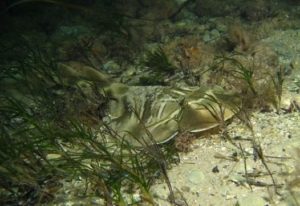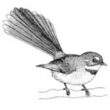It’s been so hot lately, I felt the need to take Fauna Friday into the ocean for a refreshing dip this week and cool off with the Southern Fiddler Ray (Trygonorrhina dumerilii).
Fiddler Rays are from the Family Rhinobatida, which also includes guitarfishes and shovelnose rays. Australia has two Fiddler Ray species (sometimes also referred to as Banjo Rays); the other being the Eastern Fiddler Ray from the waters along the east coast. Fiddler Rays are not Stingrays (Family Dasyatidae) and do not have a venomous spine in their tail. However they do sport a thorny row of denticles (calcified, tooth-like structures) along their back.

Southern Fiddler Rays grow to about 1.5m and have flattened, rounded bodies and a long lobed tail with two short dorsal fins – a shape which is reminiscent of a fiddle or banjo (hence their name). Three parallel grey-white stripes extending from just behind their eyes provide a striking contrast against their yellow-brown body.
The specie is common throughout coastal waters and is mostly found close to the sea floor in the shallows where they feed on shellfish, marine worms and crabs, crushing them with small, strong teeth. During the day Southern Fiddler Rays rest by shuffling down into the soft sea floor substrate and in amongst seagrasses of estuarine environments.
Reproduction in the Southern Fiddler Ray is fascinating: they are ovoviviparous – a zoological term meaning the female gestates her fertilised eggs inside her body and then gives birth to live young. In Southern Fiddler Rays the main gestation period is 4-5 months. The female can then pause the development of her embryos for another 7-8 months before giving birth (usually to 4-6 young)12 months after conception! This strategy allows the female to respond to optimum conditions and give birth when ocean temperatures favour rapid growth and prey is plentiful – prefect for giving her babies the best chance of survival.
